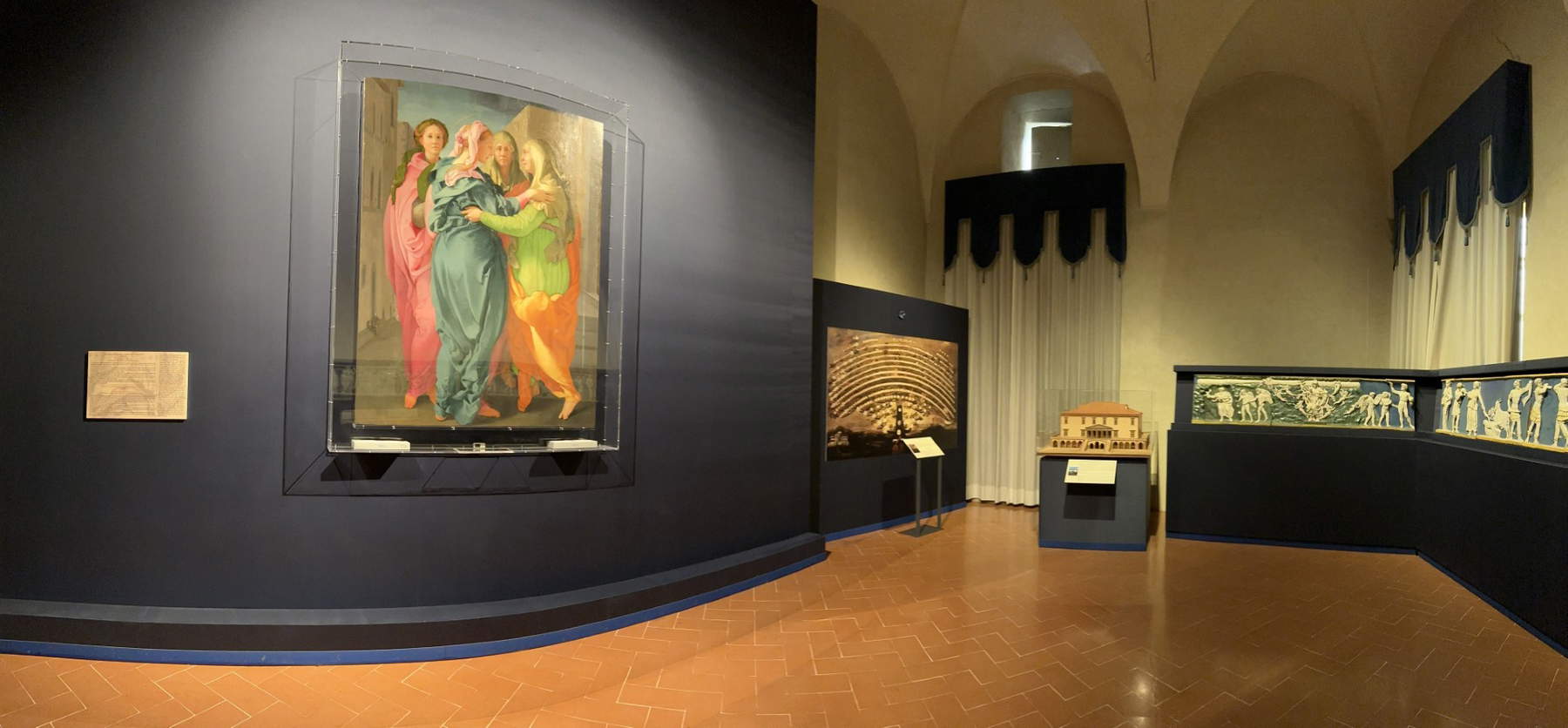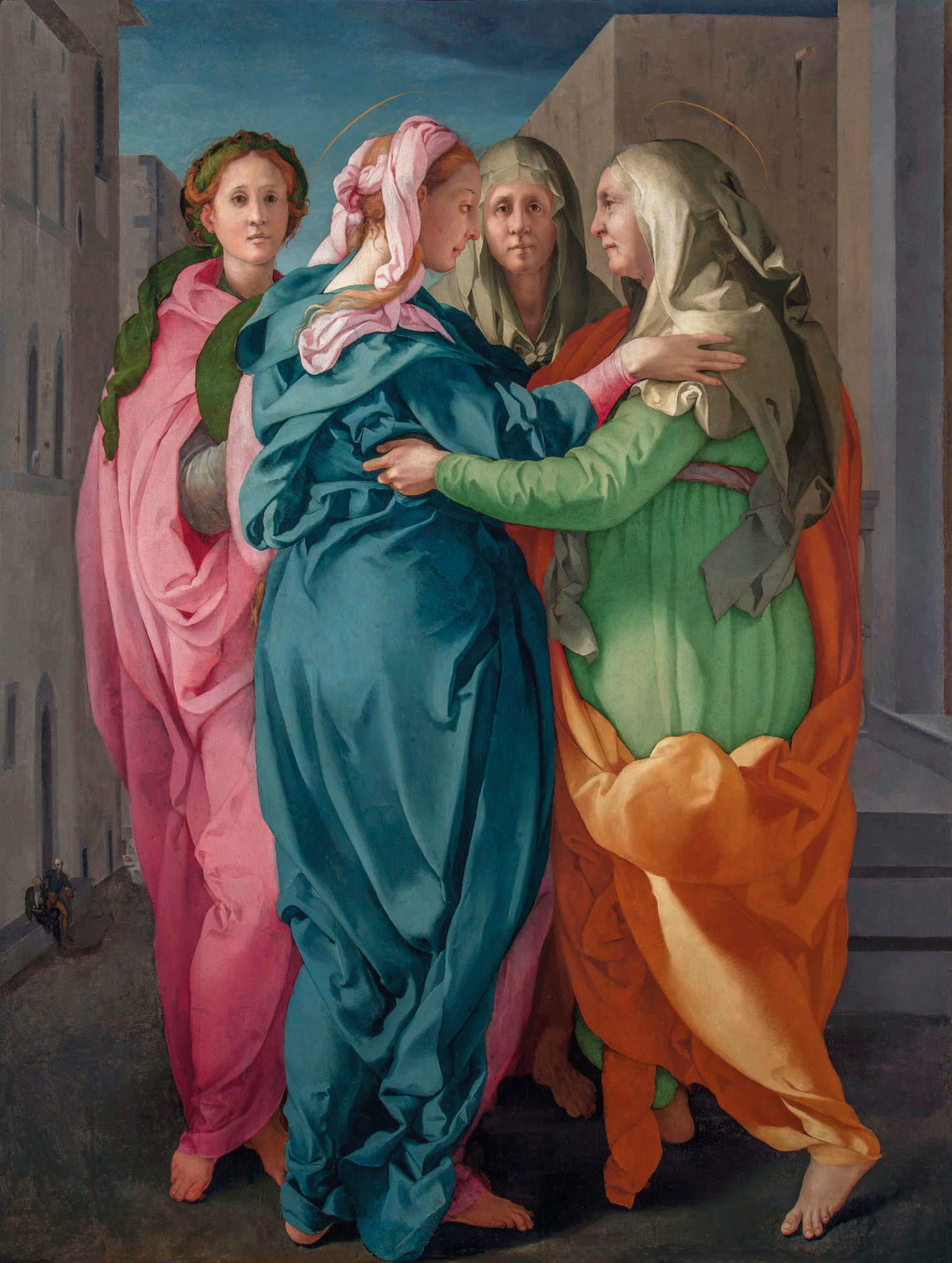New display of Pontormo's Visitation ready: it can be seen in Poggio a Caiano
After the completion of the installation work and the making of the protective case, Pontormo ’s (Jacopo Carucci; Pontorme, 1494 - Florence, 1557) The Visitation (La Visitazione ), recently transferred from the Pieve di Carmignano, will be on public display again from tomorrow, October 5, 2024. The painting will be placed in the Hall of the Frieze of the Villa of Poggio a Caiano, a short distance from the Hall of Leo X, where another of the artist’s masterpieces, the fresco Vertumno and Pomona, painted in 1520-21, is located.
To support this project, the General Directorate of Museums has allocated a grant of 35,000 euros for operations related to the installation of The Visitation in the Hall of Frieze, including adjustments to the microclimatic conditions necessary to protect the work. In the Sala della Giostra of the Municipality of Poggio a Caiano, which provided a significant financial contribution for the transportation and handling of The Visitation, as well as the creation of its protective case, other altarpieces from the Pieve have also been on display since September. These include the Madonna of Mount Carmel and Saints by Giovan Pietro Naldini, theAnnunciation and Nativity by the Florentine school, the Madonna of the Rosary by Cosimo Lotti and theEcstasy of St. Francis by Cigoli.
The Visitation, part of the new autonomous institute of the MiC - Florentine Villas and Monumental Residences, directed byFederica Bergamini, was painted by Pontormo between 1528 and 1529 for the chapel of the Pinadori, a family of wealthy anti-Medicean apothecaries within the Pieve di Carmignano. Although the work was never mentioned by Vasari, it made a comeback thanks to Carlo Gamba’s attribution in 1924. The attribution is based on a passage in the 1677 Bocchi-Cinelli that mentions a preparatory model for the Pinadori, already at the time associated with Pontormo. Although traces of the model have been lost, some preparatory drawings are preserved in the Gabinetto Disegni e Stampe degli Uffizi. From the testamentary dispositions of Bartolomea del Pugliese, Paolo Pinadori’s wife, dated June 25, 1538, we learn that the work had already been completed and intended for the family altar in the Pieve di Carmignano. Paolo Pinadori’s death in 1526 probably provided an opportunity to renovate the family chapel and commission the new altarpiece. The Pinadori family were also suppliers of colors for artists and had the opportunity to get to know Pontormo through Ludovico Capponi and the Confraternita di San Sebastiano, to which the young Bonaccorso Pinadori, Carucci, and Bronzino belonged, the latter also known to have painted a portrait of Pinadori.
The altarpiece depicts the encounter between Mary and her cousin Elizabeth, both pregnant, as narrated in the Gospel of Luke. The two female figures, monumental and slender, unite in a vibrant and vivid embrace, representing the human soul in a moment suspended between the real and the unreal. Their faces, marked by an expression of deep emotion, reflect a complex and tormented interiority, while their bodies, dressed in bright, iridescent colors, create a mystical atmosphere that transcends the earthly dimension. The context is typically Florentine, with tall palaces characterized by pietra serena ashlar and string-course cornices. As Vasari wrote, Pontormo was an artist “of singular ingenuity and very proper manner,” capable of translating the subtlest nuances of the human soul into images. The work, far from the classical schemes, is today considered almost a manifesto of the restlessness of Mannerism, because of its figures with elongated and ovoid shapes, unnaturalistic poses, anti-naturalistic use of colors, and search for a restless and tormented beauty. In 1995, U.S. artist Bill Viola, after accidentally seeing the work on the cover of a volume, was so impressed by it that he created The Greeting, an audio-video installation paying homage to the painting. To emphasize the mystery of the encounter between the two women, Viola used extreme slow motion, dilating a forty-five-second action into a ten-minute video. The impact of Pontormesque poetics was such that, in 2013, Viola wanted to dedicate a sentence to the great Florentine master, concluding with the touching expression “with gratitude and respect.”






“The agreement between the relevant institutes of the Ministry of Culture, the Diocese of Pistoia and the Parish of Carmignano, and the municipalities involved,” says Stefano Casciu, regional director National Museums of Tuscany, "has produced a result with which we are very pleased: exhibiting Pontormo’s celebrated masterpiece, an icon of his inimitable style, in the conditions of maximum safety and accessibility, in the Villa that was once Lorenzo the Magnificent’s and which houses another equally famous masterpiece by the artist, the lunette with Vertumno and Pomona. I am certain that the whole territory will benefit greatly from this temporary placement in Poggio a Caiano, in the hope that the Pieve di San Michele Arcangelo will be able as soon as possible to return to host a work that is identifiable to the entire community of Carmignano."
“It is a great honor for the Medici Villa of Poggio a Caiano and for the Autonomous Museum of Florentine Villas and Monumental Residences to be able to return Pontormo’s Visitation to the public,” says Federica Bergamini, director of the Florentine Villas and Monumental Residences. “On the main floor of the Villa, visitors will be able to immerse themselves in rare as well as unpublished short-circuits between the great painting of the 16th century and many other enigmatic works, such as the frieze attributed to Bertoldo. Poggio a Caiano thus becomes a fascinating museum itinerary, even richer and certainly unexpected.”
“The choice of the Villa of Poggio a Caiano,” comments Superintendent Antonella Ranaldi, “seemed the most opportune and convincing dictated by historical and artistic affinities and above all by the Visitation’s connection to the territory to which it belongs. In fact, it offers an extra attraction, among great masterpieces, such as the magnificent Medici Villa, for visitors, while thinking about bringing the Pieve di San Michele Arcangelo in Carmignano back to the safety conditions that will allow the return of the works to that location.”
“Making Pontormo’s Visitation and the artistic heritage housed in the Pieve di San Michele Arcangelo available for the enjoyment of the entire community,” emphasizes the Bishop of Pistoia and Pescia, Bishop Fausto Tardelli, “is a moment of joy. I am certain that this placement at the Villa Medicea in Poggio a Caiano, which guarantees accessibility and security and which has seen full collaboration among the institutions involved, will enhance not only the works housed, but will also be a valuable driving force to maintain a high level of attention and interest in the recovery and enjoyment of the Pieve di San Michele, returning its church to the community of Carmignano as soon as possible.”
“As the Municipality of Poggio a Caiano, we cannot but say we are proud to have carried out such an important cultural operation,” stresses Culture Councillor Diletta Bresci. “The works that have arrived in Poggio a Caiano add to the luster of our territory and go to enrich our already vast artistic and cultural heritage. A great satisfaction for us that also comes from the fact that the Visitation and the altarpieces have remained within the Medici communes, what we can define as their natural habitat.”
 |
| New display of Pontormo's Visitation ready: it can be seen in Poggio a Caiano |
Warning: the translation into English of the original Italian article was created using automatic tools. We undertake to review all articles, but we do not guarantee the total absence of inaccuracies in the translation due to the program. You can find the original by clicking on the ITA button. If you find any mistake,please contact us.



























